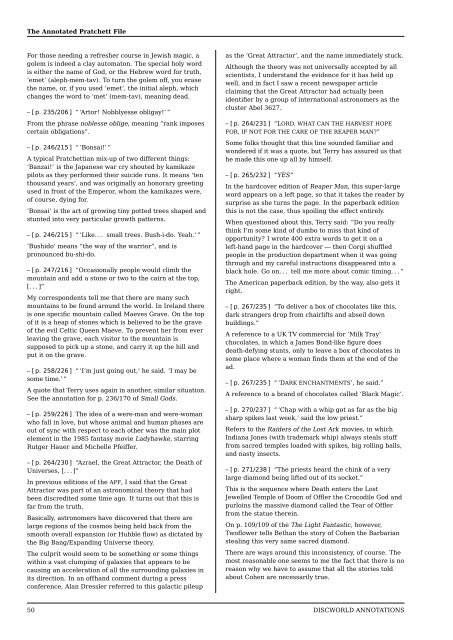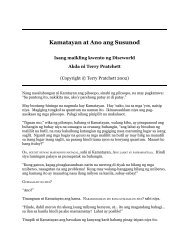The Annotated Pratchett File, v9.0 - The L-Space Web
The Annotated Pratchett File, v9.0 - The L-Space Web
The Annotated Pratchett File, v9.0 - The L-Space Web
You also want an ePaper? Increase the reach of your titles
YUMPU automatically turns print PDFs into web optimized ePapers that Google loves.
<strong>The</strong> <strong>Annotated</strong> <strong>Pratchett</strong> <strong>File</strong><br />
For those needing a refresher course in Jewish magic, a<br />
golem is indeed a clay automaton. <strong>The</strong> special holy word<br />
is either the name of God, or the Hebrew word for truth,<br />
‘emet’ (aleph-mem-tav). To turn the golem off, you erase<br />
the name, or, if you used ‘emet’, the initial aleph, which<br />
changes the word to ‘met’ (mem-tav), meaning dead.<br />
– [ p. 235/206 ] “ ‘Artor! Nobblyesse obligay!’ ”<br />
From the phrase noblesse oblige, meaning “rank imposes<br />
certain obligations”.<br />
– [ p. 246/215 ] “ ‘Bonsai!’ ”<br />
A typical <strong>Pratchett</strong>ian mix-up of two different things:<br />
‘Banzai!’ is the Japanese war cry shouted by kamikaze<br />
pilots as they performed their suicide runs. It means ‘ten<br />
thousand years’, and was originally an honorary greeting<br />
used in front of the Emperor, whom the kamikazes were,<br />
of course, dying for.<br />
‘Bonsai’ is the art of growing tiny potted trees shaped and<br />
stunted into very particular growth patterns.<br />
– [ p. 246/215 ] “ ‘Like. . . small trees. Bush-i-do. Yeah.’ ”<br />
‘Bushido’ means “the way of the warrior”, and is<br />
pronounced bu-shi-do.<br />
– [ p. 247/216 ] “Occasionally people would climb the<br />
mountain and add a stone or two to the cairn at the top,<br />
[. . . ]”<br />
My correspondents tell me that there are many such<br />
mountains to be found around the world. In Ireland there<br />
is one specific mountain called Maeves Grave. On the top<br />
of it is a heap of stones which is believed to be the grave<br />
of the evil Celtic Queen Maeve. To prevent her from ever<br />
leaving the grave, each visitor to the mountain is<br />
supposed to pick up a stone, and carry it up the hill and<br />
put it on the grave.<br />
– [ p. 258/226 ] “ ‘I’m just going out,’ he said. ‘I may be<br />
some time.’ ”<br />
A quote that Terry uses again in another, similar situation.<br />
See the annotation for p. 236/170 of Small Gods.<br />
– [ p. 259/226 ] <strong>The</strong> idea of a were-man and were-woman<br />
who fall in love, but whose animal and human phases are<br />
out of sync with respect to each other was the main plot<br />
element in the 1985 fantasy movie Ladyhawke, starring<br />
Rutger Hauer and Michelle Pfeiffer.<br />
– [ p. 264/230 ] “Azrael, the Great Attractor, the Death of<br />
Universes, [. . . ]”<br />
In previous editions of the APF, I said that the Great<br />
Attractor was part of an astronomical theory that had<br />
been discredited some time ago. It turns out that this is<br />
far from the truth.<br />
Basically, astronomers have discovered that there are<br />
large regions of the cosmos being held back from the<br />
smooth overall expansion (or Hubble flow) as dictated by<br />
the Big Bang/Expanding Universe theory.<br />
<strong>The</strong> culprit would seem to be something or some things<br />
within a vast clumping of galaxies that appears to be<br />
causing an acceleration of all the surrounding galaxies in<br />
its direction. In an offhand comment during a press<br />
conference, Alan Dressler referred to this galactic pileup<br />
as the ‘Great Attractor’, and the name immediately stuck.<br />
Although the theory was not universally accepted by all<br />
scientists, I understand the evidence for it has held up<br />
well, and in fact I saw a recent newspaper article<br />
claiming that the Great Attractor had actually been<br />
identifier by a group of international astronomers as the<br />
cluster Abel 3627.<br />
– [ p. 264/231 ] “LORD, WHAT CAN THE HARVEST HOPE<br />
FOR, IF NOT FOR THE CARE OF THE REAPER MAN”<br />
Some folks thought that this line sounded familiar and<br />
wondered if it was a quote, but Terry has assured us that<br />
he made this one up all by himself.<br />
– [ p. 265/232 ] “YES”<br />
In the hardcover edition of Reaper Man, this super-large<br />
word appears on a left page, so that it takes the reader by<br />
surprise as she turns the page. In the paperback edition<br />
this is not the case, thus spoiling the effect entirely.<br />
When questioned about this, Terry said: “Do you really<br />
think I’m some kind of dumbo to miss that kind of<br />
opportunity I wrote 400 extra words to get it on a<br />
left-hand page in the hardcover — then Corgi shuffled<br />
people in the production department when it was going<br />
through and my careful instructions disappeared into a<br />
black hole. Go on. . . tell me more about comic timing. . . ”<br />
<strong>The</strong> American paperback edition, by the way, also gets it<br />
right.<br />
– [ p. 267/235 ] “To deliver a box of chocolates like this,<br />
dark strangers drop from chairlifts and abseil down<br />
buildings.”<br />
A reference to a UK TV commercial for ‘Milk Tray’<br />
chocolates, in which a James Bond-like figure does<br />
death-defying stunts, only to leave a box of chocolates in<br />
some place where a woman finds them at the end of the<br />
ad.<br />
– [ p. 267/235 ] “ ‘DARK ENCHANTMENTS’, he said.”<br />
A reference to a brand of chocolates called ‘Black Magic’.<br />
– [ p. 270/237 ] “ ‘Chap with a whip got as far as the big<br />
sharp spikes last week,’ said the low priest.”<br />
Refers to the Raiders of the Lost Ark movies, in which<br />
Indiana Jones (with trademark whip) always steals stuff<br />
from sacred temples loaded with spikes, big rolling balls,<br />
and nasty insects.<br />
– [ p. 271/238 ] “<strong>The</strong> priests heard the chink of a very<br />
large diamond being lifted out of its socket.”<br />
This is the sequence where Death enters the Lost<br />
Jewelled Temple of Doom of Offler the Crocodile God and<br />
purloins the massive diamond called the Tear of Offler<br />
from the statue therein.<br />
On p. 109/109 of the <strong>The</strong> Light Fantastic, however,<br />
Twoflower tells Bethan the story of Cohen the Barbarian<br />
stealing this very same sacred diamond.<br />
<strong>The</strong>re are ways around this inconsistency, of course. <strong>The</strong><br />
most reasonable one seems to me the fact that there is no<br />
reason why we have to assume that all the stories told<br />
about Cohen are necessarily true.<br />
50 DISCWORLD ANNOTATIONS














